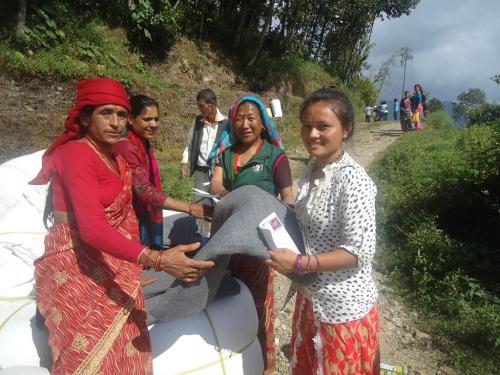
A Nepali friend recently said to me that “winterization” is a new word in Nepal. Prior to the earthquake in elevations above 1500 meters, winterization hadn’t been an issue. However with large numbers of people living in temporary shelters, there is a concern as to how they will manage in colder weather.
An 11 page document, “Technical Annex-Winter Guidance” provided by the Shelter Cluster Nepal notes that winterization support items includes-clothes, blankets, mattresses, floor mats, stoves, cook sets and lighting.
At an early August meeting of the national Shelter Cluster Lena Siedentopp from the International Organization of Migration (IOM), announced that IOM had winterization items. Along with my colleague Bishwash Nepali from Community Self Reliance Centre (CSRC) we introduced ourselves and a few days later had a meeting at IOM.
Throughout the country CSRC’s work involves land rights. However, due to the earthquake and being donor driven, this has broadened out to a number of other areas including a larger focus on livelihoods. This has resulted in NGOs building their capacities to work in a number of complementary areas (besides their main focus).
Since the immediate aftermath of the earthquake, IOM became a key shelter responder managing the pipeline which delivers shelter and non-food items (NFIs) with implementation partners to the most affected districts. As the winter looms, IOM assists affected families with winter coping strategies based on their needs. IOM continues to provide the pipeline with Winterization Packages to keep the immediate space around bodies’ warm and providing protection to their shelter from the elements. (IOM’s Shelter Program distributes shelter items with assistance from 40 local and international organizations in 19 districts, and had reached 146,742 families by October 2015).
IOM staff visited CSRC with a checklist, documents were traded back and forth, signed and finally CSRC was approved for 5199 blankets (more than 8300 kg) to cover all households in Dhaibung, Bhorle, Haku and Laharepauwa (Rasuwa) VDCs. This would be a present for the many people living in these areas, taking 11 days to complete delivery.
The next step in the process was to arrange logistics, trucking the blankets, from a storage facility at the Tribhuvan International Airport to Rasuwa. The Logistics Cluster (earthquake response), of which the World Food Program (WFP) is the lead agency, provides storage capacity for the whole humanitarian community, as well as road transport services with origin and destination within the six most affected districts, including Rasuwa. To date, a total of 64,899 m3 (28,522 mt) of cargo has been handled through the Logistics Cluster on behalf of 151 different organisations. However, the petrol crisis and the need to move items quickly complicated transportation.
In Rasuwa, CSRC has been working on developing livelihood and complementary partnerships with Cordaid and its partners Lumanti and Parivartan and Helen Keller International (Suaahara project). Needing to find transportation partners these organizations came through. The next step was to transport the items from Kalikastan in Dhaibung to each of the four VDCs; the Logistics Cluster came through, providing transportation. Finally the 5000 blankets had to be distributed to every household in each of the four VDCs which is being accomplished by the CSRC Rasuwa staff and frontline leaders from the District Land Rights Forum (DLRF) with assistance from Nepal Agroforestry Foundation staff.
Getting 5000+ blankets to Rasuwa and distributed in some areas which are inaccessible is a small project, but took a large amount of effort from a number of partners. When I think about multiplying this to getting blankets and/or other winterization and other items to households in earthquake impacted districts and the massive amount of human, financial and other resources which are needed I realize the importantance of partnerships. Larger organizations such as the IOM and WFP are key to securing necessary donations and providing logistical support. But it is the smaller and national NGOs which have to ensure that necessary items are delivered in a timely fashion. In humanitarian terms, which this example demonstrates, without partnerships programs will not be successful.










Add new comment